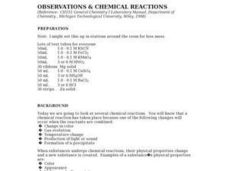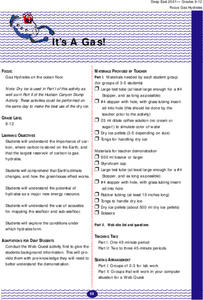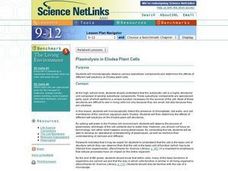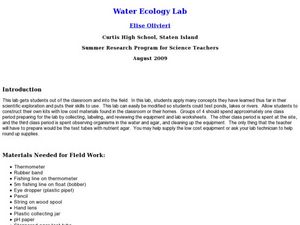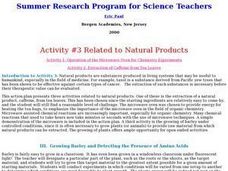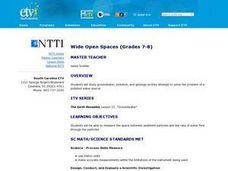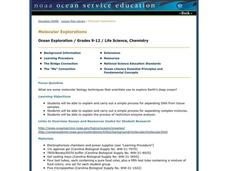Curated OER
Observations & Chemical Reactions
Young scholars conduct a series of experiments in which they explore chemical reactions. They detect chemical changes by observing how physical properties change when two different chemicals are combined. They list and describe the...
Curated OER
Primary and Secondary Colors
Students explore primary and secondary colors. In this art lesson, students use jars of colored water to create the secondary colors.
Curated OER
A Better Way
Students increase awareness of organizations that grew out of necessity and increased social consciousness during the Civil War and Reconstruction. They trace the origins of three organizations founded for the common good. They link...
Curated OER
Chemical Magic
Students identify acids and bases. In this chemistry lesson plan, students use red cabbage juice as an indicator of whether the liquid is an acid or base. Students discuss the results.
Curated OER
Coevolution: A Simulation
Students participate in a demonstration in which they must attempt to suck liquid from varying containers with straws of varying sizes. They discuss the concept of coevolution and see why this activity illustrate the coevolution of...
Curated OER
Yeast Cells and their Environment
Students study the scientific method and explore how to design an experiment. In this investigative lesson students explore and hypothesis an experiment then carry it out to find the results.
Curated OER
It's a Gas!
High schoolers explore the conditions under which hydrates form. They use the Internet to access information and conduct experiments to examine how the greenhouse effect works.
Curated OER
Bubonic Plague
Students study the history of the causes and spread of the Bubonic Plague. They determine what groups of people were affected by the disease and locate the geographic areas they resided in. Working in small groups they conduct a an...
Curated OER
The Hijacker - How a Virus Spreads
Students view a video that presents how viruses attack the body and how the body's immune system responds. They simulate the spread of an infectious disease and establish the identity of the original carrier.
Curated OER
Plasmolysis in Elodea Plant Cells
Young scholars microscopically observe various subcellular components. They determine the effects of different salt solutions on Elodea plant cells. Students explain the major function of a cell membrane and describe its structure.
Curated OER
Quake Clues
Students study earthquakes and how sediment accumulations are used for past information on earthquakes. In this earthquake lesson students interpret sediment cores and describe turbidites.
Curated OER
Water Ecology Lab
Students determine the characteristics of a stream ecosystem and its organisms. In this water ecology lesson students complete several labs that shows them presence of life, water appearance, and water flow.
Curated OER
Where in the World is Carbon Dixoide?
Students conduct experiments designed to detect the presence of CO2 by using a BTB that changes color (blue to yellow) in the presence of CO2. First, students experiment with the CO2 from combining vinegar and baking soda. In part two,...
Curated OER
From Vibration to Sound
Students observe a series of demonstrations to illustrate wave movement. In this sound wave lesson, students witness how objects create waves when dropped in a dish of water, use a rope and slinky to produce transverse and longitudinal...
Curated OER
Extract Your Own DNA from Cheek Cells
Students observe their own DNA. In this DNA instructional activity, students learn the simple method of DNA extraction and explain why DNA extraction is important to scientists.
Curated OER
DNA Transformation of Bacteria-Ampicillin
Students demonstrate how genes can be transferred from one bacteria to another. In this experiment, they take a plasmid with a gene for resistance to the antibiotic ampicillin which is used to transfer the resistance gene into a...
Curated OER
Porosity and Permeability
Young scholars examine the concepts of porosity and permeability. They conduct experiments to determine the porosity and permeability of gravel, sand, and clay. After performing the experiments they collect and graph data, comparing...
Curated OER
There's Always Room For Jell-O
Students explore the breakdown of proteins. They cut wells in Jell-O and observe as the detergent digests the Jell-O. Students record their observations and take measurements.
Curated OER
What Is the Freezing Point?
Young scholars remove heat energy and determine how it causes a phase change.
Curated OER
Plant Pigment Chemistry
Students discover the roles of pigments present in leaves. They extract and isolate pigments present in autumn leaves using a thin layer chromatography. Very nice lesson and lab!
Curated OER
Growing Barley and Detecting the Presence of Amino Acids
Pupils produce the greatest mass of plant material possible for 100 seeds of barley, and detect amino acids in barley plant material. They develop rules for the investigation, conduct the experiment, and prepare a computer spreadsheet...
Curated OER
Wide Open Spaces
Students examine the problem of groundwater pollution. In groups, they develop a solution to solve the problem of a local polluted water source. They also practice measuring the space between sediment particles and the rate of water flow.
Curated OER
Blood: Transport and Protection
In this blood activity, students review what makes up blood: plasma, platelets, and red and white blood cells. Students also learn how the blood helps fight viruses, bacteria, and other foreign substances. This activity has 10 fill in...
Curated OER
Molecular Explorations
Students explain the processes for separating DNA from tissue and separating complex mixtures. In this exploratory lesson students complete a lab where they extract DNA.
Other popular searches
- Test Tube Babies
- Test Tube Sex
- Pod Test and Tuberculosis
- Pd Test and Tuberculosis
- Ppd Test and Tuberculosis
- Test Tube Science
